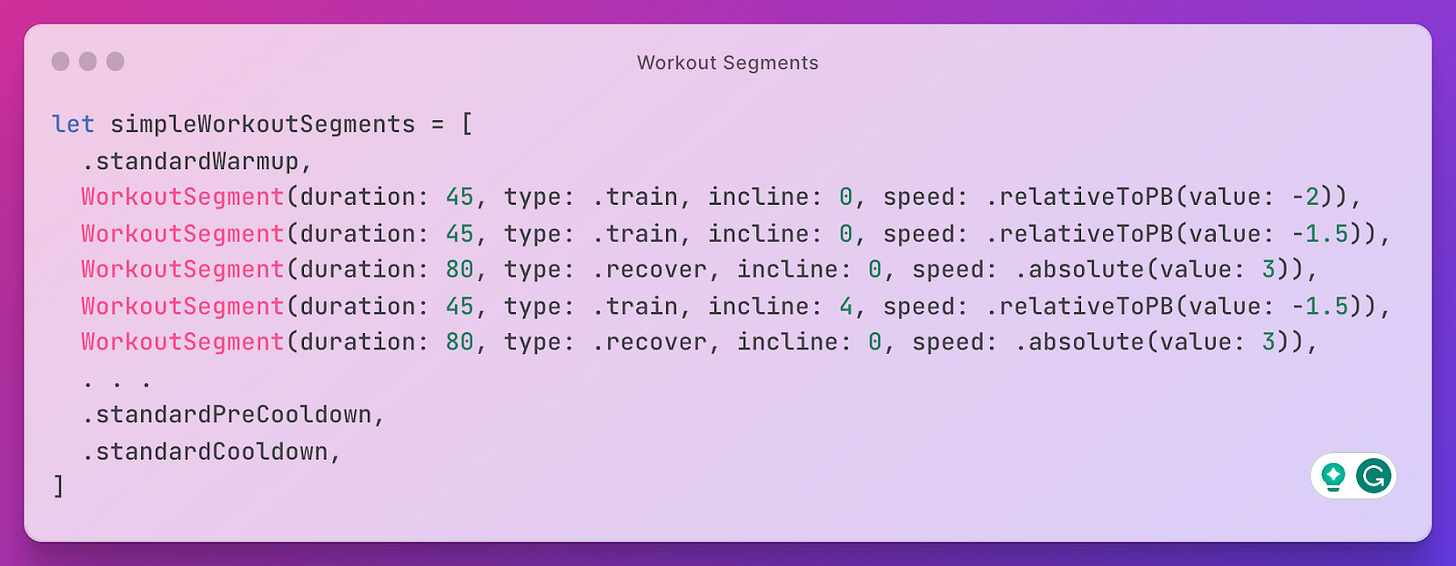Push Training: Personalizing Treadmill Experiences with Dynamic Coaching, Music, and Workouts
Introduction
As someone who spends a significant amount of their day at a desk, I recognize the importance of physical activity and have been passionate about regularly going to the gym for a number of years. Despite frequently exercising, cardio always seemed like a chore—especially running on a treadmill. That changed when I took a running class and found myself engaged and challenged by a coach guiding me through different workout sections. In particular, the interval-based workout naturally broke up the full workout into smaller and more manageable segments. I wanted to replicate this experience by leveraging my other passion and expertise in creating top-tier experiences for mobile devices.
The Need for Personalization
There are many on-demand workout apps available today, but they generally fall into two categories:
High-production value classes: These have expertly crafted, pre-recorded sessions with charismatic coaches and well-curated music. While they offer great production quality, they lack personalization. Every user, regardless of their experience level or personal goals, gets the same content. Creating new content is costly and time-consuming, requiring production staff and equipment.
Simpler, timer-based or audio-based, experiences: These apps provide audio coaching and let users play music from their own playlists. While these apps are less expensive to produce, they lack personalization in the workout and coaching, and the music often doesn't sync well.
The question then became: How can I create a high-quality workout experience that meets users where they are on their fitness journey with music and coaching they’ll love?
The Concept
With that, I set out to create Push Training—a new approach that dynamically combines workouts, coaching, and music for each user.
The core structure of a workout alternating between training and recovery intervals remains mostly unchanged. However, the difficulty, coaching, and music selections are dynamically customized for each user. This allows the user to take the same workout multiple times while the workout still being engaging, challenging, and unique.
Implementation
The personalized workout experience always starts with a static core workout structure alternating between training and recovery intervals (see Image 1). From there, the “hydrated” workout is produced (see Image 2), following the steps below.
Determine the starting timestamps for each interval.
Pair each training interval with a song by using a number of signals, including the intensity of the song’s segment along with the user’s song ratings from previous sessions.
Add coaching voice snippets for static coaching audio, aligning them with the intervals using timestamps and offset values.
Add placeholders for dynamic coaching. While these are mostly empty objects, they each contain specific context that will be used when generating coaching on the fly.
Playback: mix and align the audio tracks and visuals to create a seamless playback experience.
A multitrack audio player is used to manage the lifecycles of different audio players—ensuring proper track playback times and volumes are used at any given point in time.
A dynamic voice track manager is used to populate the empty dynamic coaching placeholders using the context they hold. It’s constantly monitoring for changes in context that may cause a pre-fetched coaching snippet to become invalid.
With this, Push Training offers a highly-produced workout experience that is tailored to the individual user. Personally, time on the treadmill flies by as the dynamic mix of music and coaching keeps me engaged and motivated.
As the developer, adjusting existing workouts or adding new ones becomes easy and doesn't require additional resources. Eventually, users will be able to build their own custom workouts or have AI generate new ones for them.
Challenges Ahead
The biggest current challenge with this approach is finding suitable music that is engaging, fits the brand, and has adequate lead time and length. Audio ML could be applied to edit songs to fit the specific needs of training intervals, similar to Remix in Premiere Pro. If you have experience in this area, I’d love to chat!
Final Thoughts
Early feedback has been promising, with subscription purchases and repeat users. One user completed a workout nearly every day for their first three weeks, sometimes even doing two workouts in one day.
Although it's still in its early days, I'm excited about the potential of Push Training and the positive impact it could have on users' fitness journeys.
If you share a passion for helping people stay healthy and active, I'd love to hear from you! Reach me by email using my first name at pushtrainingapp.com, or find me on LinkedIn.



